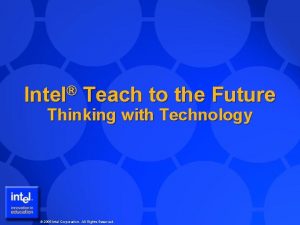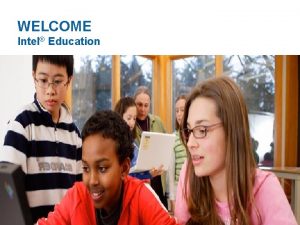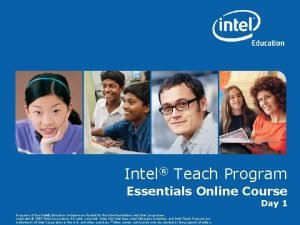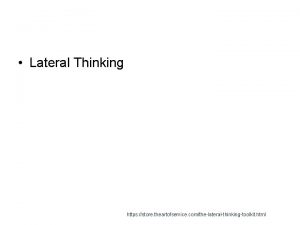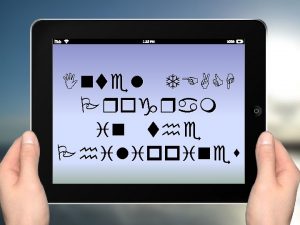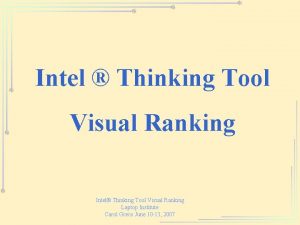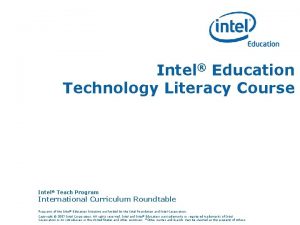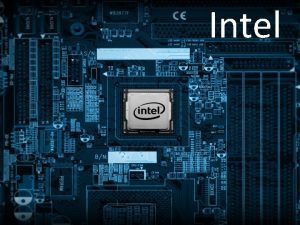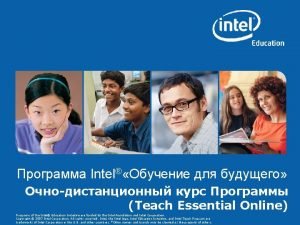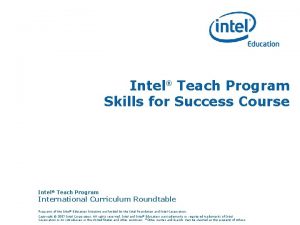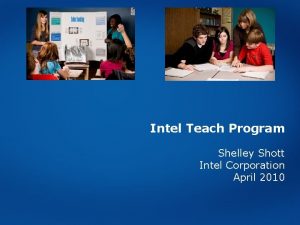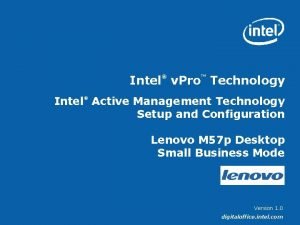Intel Teach to the Future Thinking with Technology

















- Slides: 17

® Intel Teach to the Future Thinking with Technology © 2005 Intel Corporation. All Rights Reserved.


Thomas Gradgrind’s Philosophy “Facts alone are wanted in life” l Head knowledge, not lived experience l Exercise of power leads to fear l Non-relational l

Thinking in the Classroom l l l Work in pairs. Open the Vignettes on Thinking in the Classroom (CD Module: Questions and thinking, Challenging Thinking – Activity 1. 2) or (Page A-19 to A-21) Read the example of your choice (5 min. ). Discuss the questions with a partner (15 min. ). Class discussion (10 min. ).

3 th Grade Maths Exercise Mrs Chen: l Thinking promoted l Exploration encouraged Mr Mollo: l Quick answers l Pre-determined structure l

7 th Grade Nutrition Exercise Mrs Chetty: l Engaging activities l But not linked to learners own experiences Mr Horton: l Open-ended question l Authentic problem l

21 st Century Skills Accountability & Adaptability Communication Skills Creativity & Intellectual Curiosity Critical Thinking, Systems Thinking Information & Media Literacy Interpersonal and Collaborative Skills Problem Solving Self-Direction Social Responsibilit www. 21 stcenturyskills. org

Critical Outcomes Problem Solving, Decision Making Collaboration Self-organisation Collect, analyse, organise & critically evaluate information Communication Effective, safe use of Science & Technology See the world as inter-related systems

Marzano (Page A-17) Dimensions of Learning 1 Positive Attitudes and Perceptions about Learning 2 Acquisition and Integration of Knowledge Facts and procedures 3 Extension and Refinement of Knowledge Comparing, classifying, common reasoning processes, analysing 4 Meaningful use of Knowledge Decision Making, Investigation, Experimental Inquiry, Problem solving, Invention 5 Productive Habits of Mind Critical thinking, Creative thinking, Self-regulation

Marzano’s Model of Thinking At a Glance: Marzano’s Dimensions of Learning • Categories do not build upon each other • Each cognitive category is just as important as the others • All categories are worthy of focus and inclusion within a unit of study © 2005 Intel Corporation. All Rights Reserved.

Activity: Visual Ranking Reflect on a recent lesson or unit of work l Rank the aspects of Marzano’s Dimensions of Learning according to what you prioritised in a recent lesson or unit l Go to this page to log in: l http: //www 97. intel. com/workspace/student/login. aspx? LID=en (Use Power. Point Outline or Visual Ranking)

Costa & Kallick: Habits of Mind Persisting Thinking and Communicating with Clarity and Precision Managing Impulsivity Gathering Data through all Senses Listening to Others with Understanding and Empathy Creating, Imagining, and Innovating Thinking Flexibly Responding with Wonderment and Awe Thinking about our Thinking Taking Responsible Risks Striving for Accuracy & Precision Finding Humour Questioning and Posing Problems Thinking Interdependently Applying Past Knowledge to New Situations Learning Continuously

Costa & Kallick At a Glance: Costa and Kallick’s 16 Habits of Mind • Definition of habits that are required to meet “challenging conditions” • To resolve a complex problem, students need ü ü ü Strategic reasoning Insightfulness Perseverance Creativity Craftsmanship © 2005 Intel Corporation. All Rights Reserved.

Bloom At a Glance: Bloom’s Taxonomy • Categorizes thinking skills from the simplest learning behavior to the most complex • Hierarchical system of thinking skills • The higher thinking levels include all of the cognitive skills from the lower levels. © 2005 Intel Corporation. All Rights Reserved.

Seeing Reason l Log onto the Thinking Tools website http: //www 97. intel. com/workspace/student/login. aspx? LID=en Bearing in mind all that we have looked at, make a “Seeing Reason” diagram that shows some of the impacts on Higher Order Thinking, positive and negative. l Create links between various factors. l Use colour to categorise your ideas l

Toulmin Claim Universities should have affirmative action admissions policies. Qualifier …if they do not have a demographically representative population Support Affirmative action provides equal access to education for all ethnic groups. Warrant Equality of access is a Basic value. Rebuttal: Backing: Affirmative action policies Equality before the law do not result in "reverse is a fundamental right discrimination" because they are only part of a process that attempts to ensure fairness in admissions and overcome past inequities.

What makes Higher Order Thinking happen? l l l Understanding multiple perspectives. Encouraging discussion and grappling with complex ideas. Dynamic visual representation of thinking. Development of verbal argumentation skills. Working with criteria for judgement Making a choice and having to justify ones ideas.
 Intel teach to the future
Intel teach to the future Intel teach
Intel teach Intel education
Intel education Intel teach programme
Intel teach programme Internal block diagram of 8086
Internal block diagram of 8086 Future perfect continuous tense example
Future perfect continuous tense example Future perfect future continuous future perfect continuous
Future perfect future continuous future perfect continuous Vmm intel virtualization technology
Vmm intel virtualization technology Positive thinking vs negative thinking examples
Positive thinking vs negative thinking examples Thinking about your own thinking
Thinking about your own thinking Holistic judgement
Holistic judgement Perbedaan critical thinking dan creative thinking
Perbedaan critical thinking dan creative thinking Thinking about you thinking about me
Thinking about you thinking about me Designer gernreich crossword
Designer gernreich crossword The perfect future tense
The perfect future tense Have en futuro simple
Have en futuro simple Future continuous and future perfect
Future continuous and future perfect Future nurse programme
Future nurse programme
